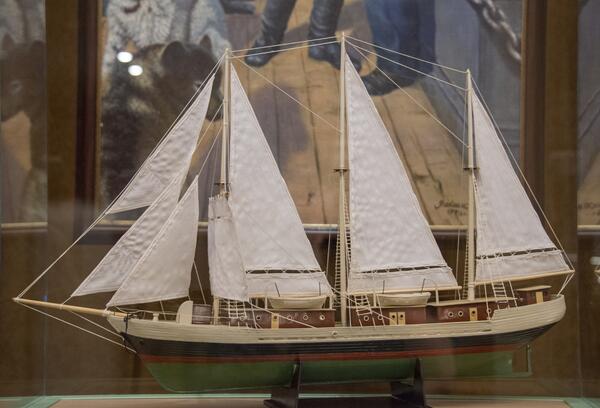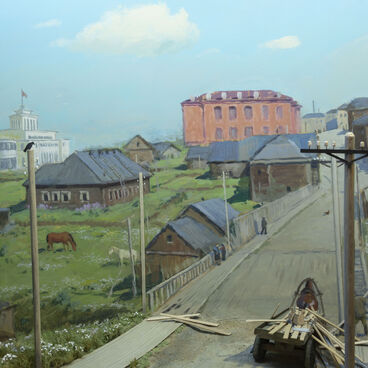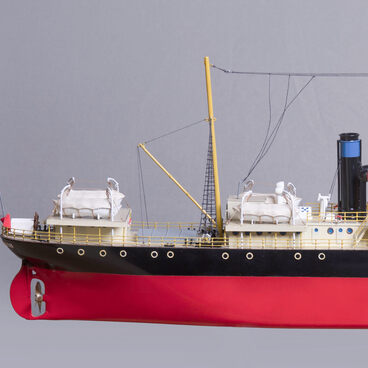The schooner Zarya made a single, but momentous voyage: the expedition of Baron Eduard Vasilievich von Toll set off on this ship in search of Sannikov Land.
Baron Toll himself was involved in the selection, purchase, and preparation of the vessel. In the autumn of 1899, he arrived in Norway and, on the advice of his Norwegian colleague, the polar explorer Fridtjof Nansen, chose the three-masted whaling bark (Harald Haarfoger), reminiscent of Nansen’s own Fram.
The vessel was originally designed as a fishing vessel for work in the Arctic Ocean. It was notable for its great strength, stability in rough seas, and good turning ability. A small circulation radius contributed to comfortable steering when navigating through broken ice.
Harald was caulked and repaired, planked with a belt of hard bakaut (green-heart — “soap wood”) with a recess below the waterline, and transferred, already under the name Zarya, to the shipyard of the shipbuilder Colin Archer. There, the spaces of the ship had to be overhauled, as the vessel had to be converted from a seal-hunting ship to a research vessel. The bulkheads were replaced, a seven-cabin deck superstructure was added and the sailing equipment was rebuilt. In the new look, the former bark corresponded to the schooner.
The Zarya is considered to be the first vessel in the history of the Russian fleet, especially and thoroughly prepared for such tasks.
In the autumn of 1902, Eduard Vasilyevich Toll and three of his companions set off for Bannet Island using dog sleds and kayaks. Unfavorable ice conditions and damage prevented the Zarya from approaching the same place on the agreed date. The hydrographer Fyodor Andreyevich Matisen, acting captain, took the vessel to Tiksi Bay.
Later, the expedition members who had remained on the ship were evacuated by the Lena, owned by the tradeswoman Anna Ivanovna Gromova. The remains of the schooner were also given to her, as agreed.
In 1915, the Zarya caught fire, scorching the vessel to the waterline. The sturdy wooden hull survived, but became firmly stuck to the ground and over time became the base for the oil jetty. It is still in use today.
The model was made by a group of artists from Saint Petersburg for the new permanent exhibition of the museum, which opened in 2011.
Baron Toll himself was involved in the selection, purchase, and preparation of the vessel. In the autumn of 1899, he arrived in Norway and, on the advice of his Norwegian colleague, the polar explorer Fridtjof Nansen, chose the three-masted whaling bark (Harald Haarfoger), reminiscent of Nansen’s own Fram.
The vessel was originally designed as a fishing vessel for work in the Arctic Ocean. It was notable for its great strength, stability in rough seas, and good turning ability. A small circulation radius contributed to comfortable steering when navigating through broken ice.
Harald was caulked and repaired, planked with a belt of hard bakaut (green-heart — “soap wood”) with a recess below the waterline, and transferred, already under the name Zarya, to the shipyard of the shipbuilder Colin Archer. There, the spaces of the ship had to be overhauled, as the vessel had to be converted from a seal-hunting ship to a research vessel. The bulkheads were replaced, a seven-cabin deck superstructure was added and the sailing equipment was rebuilt. In the new look, the former bark corresponded to the schooner.
The Zarya is considered to be the first vessel in the history of the Russian fleet, especially and thoroughly prepared for such tasks.
In the autumn of 1902, Eduard Vasilyevich Toll and three of his companions set off for Bannet Island using dog sleds and kayaks. Unfavorable ice conditions and damage prevented the Zarya from approaching the same place on the agreed date. The hydrographer Fyodor Andreyevich Matisen, acting captain, took the vessel to Tiksi Bay.
Later, the expedition members who had remained on the ship were evacuated by the Lena, owned by the tradeswoman Anna Ivanovna Gromova. The remains of the schooner were also given to her, as agreed.
In 1915, the Zarya caught fire, scorching the vessel to the waterline. The sturdy wooden hull survived, but became firmly stuck to the ground and over time became the base for the oil jetty. It is still in use today.
The model was made by a group of artists from Saint Petersburg for the new permanent exhibition of the museum, which opened in 2011.



